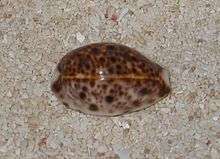Lyncina lynx
| Lyncina lynx | |
|---|---|
| | |
| Five views of a shell of Lyncina lynx | |
 | |
| A dark shell of Lyncina lynx | |
| Scientific classification | |
| Kingdom: | Animalia |
| Phylum: | Mollusca |
| Class: | Gastropoda |
| (unranked): | clade Caenogastropoda clade Hypsogastropoda clade Littorinimorpha |
| Superfamily: | Cypraeoidea |
| Family: | Cypraeidae |
| Genus: | Lyncina |
| Species: | L. lynx |
| Binomial name | |
| Lyncina lynx (Linnaeus, 1758) | |
| Synonyms[1] | |
| |
Lyncina lynx, common name : the lynx cowry or eyed cowry, is a species of sea snail, a cowry, a marine gastropod mollusk in the family Cypraeidae, the cowries.[1]
Description
Lyncina lynx is quite common. The shells of these cowries are very variabile in pattern and size. They reach on average 38–50 millimetres (1.5–2.0 in) of length, with a minimum size of 18 millimetres (0.71 in) and a maximum size of 90 millimetres (3.5 in). The dorsum surface of these smooth and shiny shells is generally pale brown, pale purple or grey, densely covered with small and large dark brown or purple dots. The large spots are extended to the edges. The base is white or pale brown. The aperture is long and narrow, with several white teeth and a bright reddish spacing. In the living cowries the mantle is transparent, with tree-shaped white sensorial papillae and may cover the entire shell.
Distribution
This species occurs in the Red Sea, in the Indian Ocean along South-East Africa (Aldabra, Chagos, Kenya, Madagascar, the Mascarene Basin, Mauritius, Réunion, the Seychelles, Zanzibar and Tanzania) and in the western Pacific Ocean (Philippines, Japan, Taiwan, western and northern Australia, Polynesia and Hawaii).
Habitat
These cowries live in tropical shallow water, subtidal and intertidal, usually under rocks or corals up to about 10 metres (33 ft)of depth. They start feeding at dusk, mainly on sponges.
Subspecies
- Cypraea lynx var. williamsi Melvill, 1888
- Cypraea (Luponia) lynx globosa Dautzenberg, 1902
- Cypraea lynx var.michaelis Melvill, 1905
- Cypraea lynx var. incrassata Dautzenberg, 1929
- Lyncina lynx pacifica Steadman & Cotton, 1943
- Cypraea (Lyncina) lynx var. javana Coen, 1949
References
- 1 2 Lyncina lynx . WoRMS (2009). Lyncina lynx. Accessed through the World Register of Marine Species at http://www.marinespecies.org/aphia.php?p=taxdetails&id=216757 on 15 October 2010.
- Lorenz F. & Hubert A. (2000) A guide to worldwide cowries. Edition 2. Hackenheim: Conchbooks. 584 pp
- Burgess, C.M. (1970). The Living Cowries. AS Barnes and Co, Ltd. Cranbury, New Jersey
External links
_-_Cypraeidae_-_Mollusc_shell.jpeg)